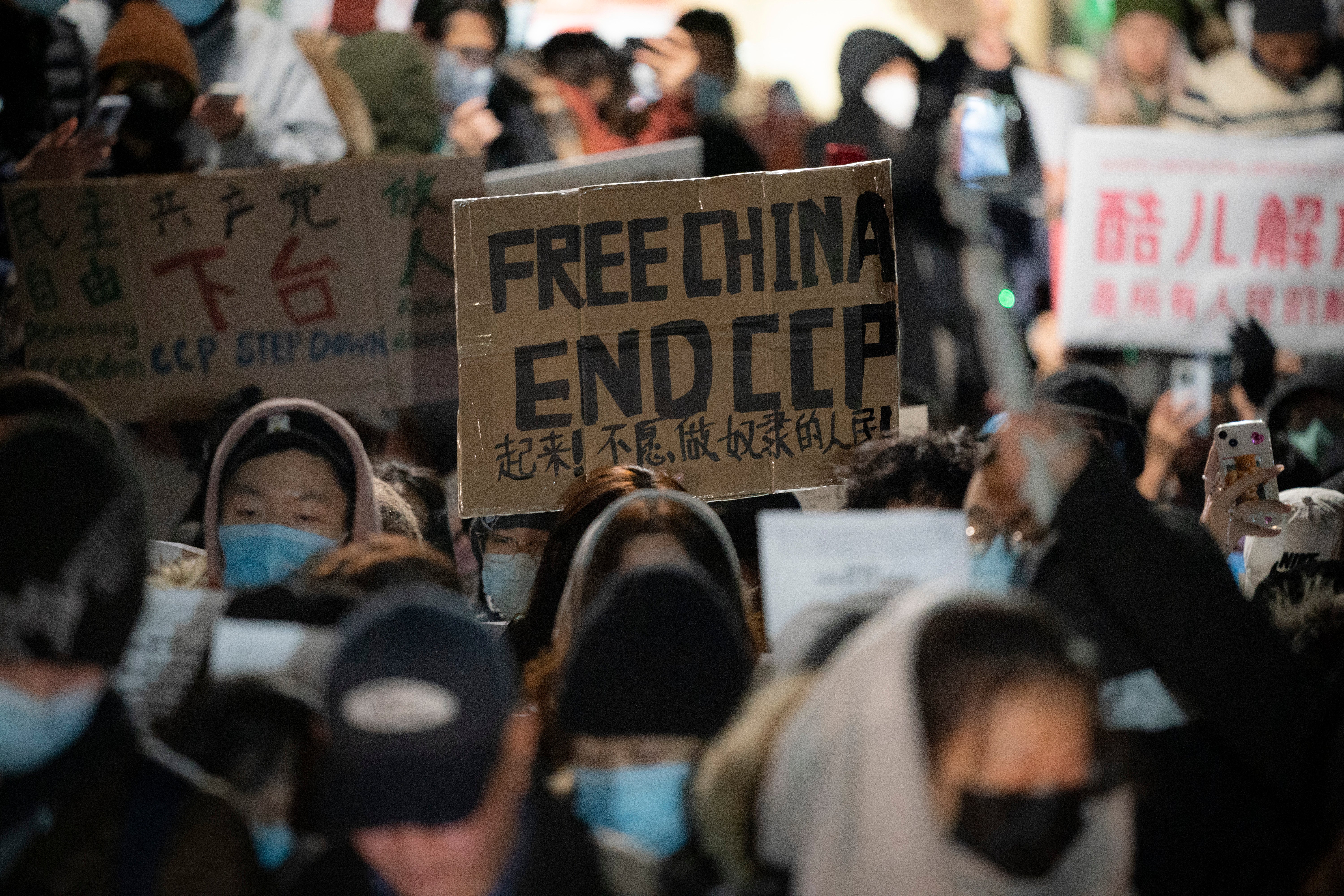What do protests in China mean for the West?
This is the most – and the most concerted – unrest to afflict the country since the Tiananmen protests of 1989, writes Mary Dejevsky


To the carnage and destruction in Ukraine, to the continuing conflict in and around Syria, to the 10 weeks of turmoil in Iran, the neighbourhood to the east of Europe and beyond is looking more uncertain than it has for a long time. Now, to this trio of conflicts, each of which has the potential to spread, must be added a global dimension with the prospect of unrest in the world’s most populous country.
It was snatched mobile phone footage posted on social media that first alerted the outside world to the dramas unfolding in China over the past week. Crowds of angry Chinese could be seen thronging the streets of Shanghai, shouting and chanting for the end of Communist Party rule and the removal of the party leader, Xi Jinping. Such an overt challenge to the powers that be is not something that happens every day in China, but it seems to be happening now rather more often, and breaking out simultaneously across more of the country.
The immediate trigger for the protests in China’s richest and most cosmopolitan city was the death toll in a fire more than 2,000 miles away in Urumqi, in the westernmost province of Xinjiang. And the anger appears to have been ignited by a belief that the victims might have been saved but for the quarantine lockdown in force at the time.
Similar protests erupted in more than a dozen Chinese cities, including Beijing. In some places, demonstrators broke out of their Covid detention, using as weapons barriers and pieces of fencing they had smashed in their determination to break free. As was widely observed, this is the most – and the most concerted – unrest to afflict China since the Tiananmen protests of 1989.
There are differences, of course. The Tiananmen protests were initially and remained largely youth protests, though workers joined in the latter stages. They were highly political and oppositional, with calls for democratisation of the system, if not the actual overthrow of the ruling party. This, however, was increasingly how the objective of the protests was viewed in the upper echelons of the Communist Party leadership, and the rest is known: martial law was declared, the army was deployed in Beijing and the tanks rolled through central Beijing, resulting in a death toll unestablished to this day.
What is hard to judge three decades later is how far this latest unrest reflects popular frustration with the government’s continuing “zero Covid” policy – and could therefore be assuaged, perhaps, by some easing of the rules – and how far it reflects wider discontent that could escalate into something far more threatening to the authorities, and to public order in general. So far, this is not clear.
Sporadic protests have broken out – mainly over the Covid lockdowns – since the early summer, but they seem to be gathering intensity and pace. Some of the most violent erupted two weeks ago at Foxconn’s enormous Apple iPhone factory complex in Zhengzhou. While the direct cause here was apparently a pay dispute, Covid rules were a factor, too, with thousands of employees confined in camp-like conditions, so they could stay at work and quarantined without going out into the wider city, or home.
While the latest protests ebb and flow, and each is infinitely smaller than the million people at one time encamped on Tiananmen Square – which makes them perhaps more easily managed by the authorities – they have been gathering pace; they have been spreading, and they have acquired a national political tinge, with the calls for Xi Jinping to go. There is also the paradox of the leadership line-up appearing thoroughly stable, with the reappointment only last month of Xi for a record third five-year term, with the emergence of discontent from below.
If it is not at all clear how this unrest might develop, even if it will develop at all and, if it does, what the authorities in Beijing might decide to do about it, we have here the spectre of disorder in China, which has – to my mind, wrongly – been excluded from almost all expert forecasts. China might continue its rise largely peacefully while suppressing the aspirations of the Uyghur and Tibetan minorities on its periphery.
But it is not a given that the centre will hold, if economic and political tensions mount. I have never forgotten what one of the Soviet Union’s old China hands told me, when he was revisiting Beijing as part of Mikhail Gorbachev’s entourage in 1989. Amazed at how China had changed, he nonetheless rationalised it to himself by arguing that China had not yet experienced its equivalent of Russia’s 1905 revolution, let alone the Bolshevik revolution of 1917. It is worth bearing in mind.
But so, too, is the prospect that those of us fortunate enough to live in Western Europe and North America – who have enjoyed nearly 80 years of peace and predictability, interrupted only by the joyous dismantling of the Berlin Wall and the relatively small wars of choice fought from afar – might soon be facing a much more disordered world.
It is not at all clear how or when the war in Ukraine will end, or indeed whether it will end without spilling out in one direction or another. There could be repercussions, as yet unknowable, for the whole continent of Europe. Iran sits at a vital crossroads; Russia looms from the north, with Iraq to its west and Afghanistan to its east – neither country being exactly a haven of tranquillity or yet charting any clear future direction.
And even if the protests in China are suppressed or die down of their own accord, they nonetheless serve as a warning. China may largely have achieved its economic miracle and be girding itself to be the dominant regional power, but the future of this vast country, too, is uncertain, as are even its short-term intentions towards Hong Kong and Taiwan.
Then there is Russia. It remains to be seen what repercussions any denouement in Ukraine might have in Russia. Military defeats present risks to the regime, and to the leader who is held responsible. And even were Russia somehow to secure a victory of sorts, part of the price is already clear: big military losses, years of rejection by the Western world and a reorientation of its energy and security policies away from the West and towards the East. Unrest cannot be ruled out in Russia either.
To keep up to speed with all the latest opinions and comment, sign up to our free weekly Voices Dispatches newsletter by clicking here
As news of the swelling protests in China spread around the Western world (though not in the official Chinese media, which ignored it), so, too, did excitement and anticipation. Some prophesied the imminent end of Xi Jinping and even a democratic China.
At which point, wiser voices entered the fray to argue that China could well weather its latest storms, as it had before; that the popular uprisings of 2010-12 across the Middle East, optimistically dubbed the Arab Spring, had come and gone without a single regime being definitively changed, let alone set on a path of democracy.
Even 1848, the famed year of revolutions, one historian pointed out, had been long in gestation. It was far more than a year. We – especially the media – were guilty of projecting our short-termist, 21st-century expectations onto what was always and everywhere a more gradual process, even if the end, when it came, could be dramatic.
This more sober assessment may indeed turn out to be right in relation to China, Iran and elsewhere. And change, let alone change for the better, might not be just around the corner. But that is a reason for caution, not for rejecting the possibility out of hand. There is war in the borderlands of Europe; there are flickers, at the very least, of social change in China and revolt in Iran; and even Russia might not be as sclerotic as it might currently look. It makes sense at least to contemplate the risk that instability will start to afflict large parts of the world at the same time – and to prepare as best we can.
Join our commenting forum
Join thought-provoking conversations, follow other Independent readers and see their replies
Comments
Bookmark popover
Removed from bookmarks